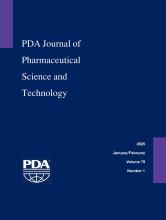Abstract
A cartridge container closure integrity control strategy may leverage a combination of test methods to ensure drug products in the assembled container system are protected from an exchange with the external environment. These methods provide evidence supporting the suitability of the container closure system; however, some methods involve extended test times, complex setups, subjective interpretation and are destructive. A method that mitigates such factors was developed to improve upon testing utilized within the control strategy. Reviewing the underlying principles of internal methods and external standards resulted in two potential paths, a Force Decay method and Constant Force method, to improve on the cartridge control strategy using a linear mechanical testing system. The Force Decay method monitors the force decay signal obtained from applying a pre-determined force and holding the displacement constant for a desired timeframe. The Constant Force method monitors the displacement signal obtained from applying a predetermined force and holding the force constant for a desired timeframe. Supplementing experimental data generated for both methods with finite element analysis along with a first principles derivation of the system response aided in a recommendation to utilize the constant force method for cartridge container closure integrity leak testing. The constant force method was then optimized to attain the best signal response for leak detection and ensure a robust method. The data generated in this article supports the viability of using the constant force mechanical container closure integrity test method for improving the in-process CCI testing strategy for solution products.
- Parenteral drugs
- constant force method
- container-closure integrity
- dye ingress test
- mechanical container-closure integrity test
- sterility
- Received January 25, 2024.
- Accepted April 15, 2025.
- Copyright © 2025, Parenteral Drug Association
PDA members receive access to all articles published in the current year and previous volume year. Institutional subscribers received access to all content. Log in below to receive access to this article if you are either of these.
If you are neither or you are a PDA member trying to access an article outside of your membership license, then you must purchase access to this article (below). If you do not have a username or password for JPST, you will be required to create an account prior to purchasing.
Full issue PDFs are for PDA members only.
Note to pda.org users
The PDA and PDA bookstore websites (www.pda.org and www.pda.org/bookstore) are separate websites from the PDA JPST website. When you first join PDA, your initial UserID and Password are sent to HighWirePress to create your PDA JPST account. Subsequent UserrID and Password changes required at the PDA websites will not pass on to PDA JPST and vice versa. If you forget your PDA JPST UserID and/or Password, you can request help to retrieve UserID and reset Password below.






